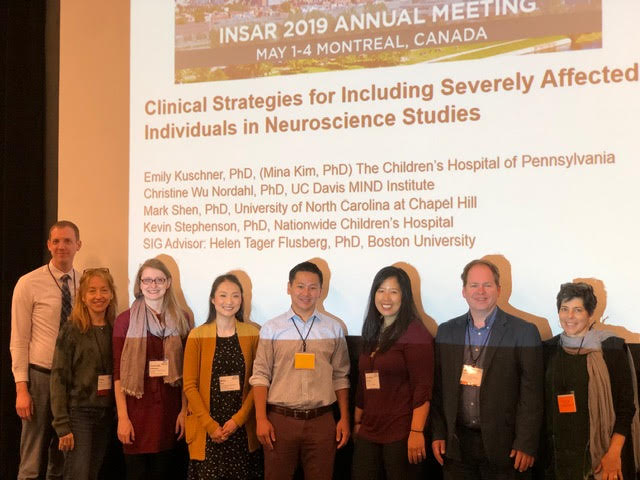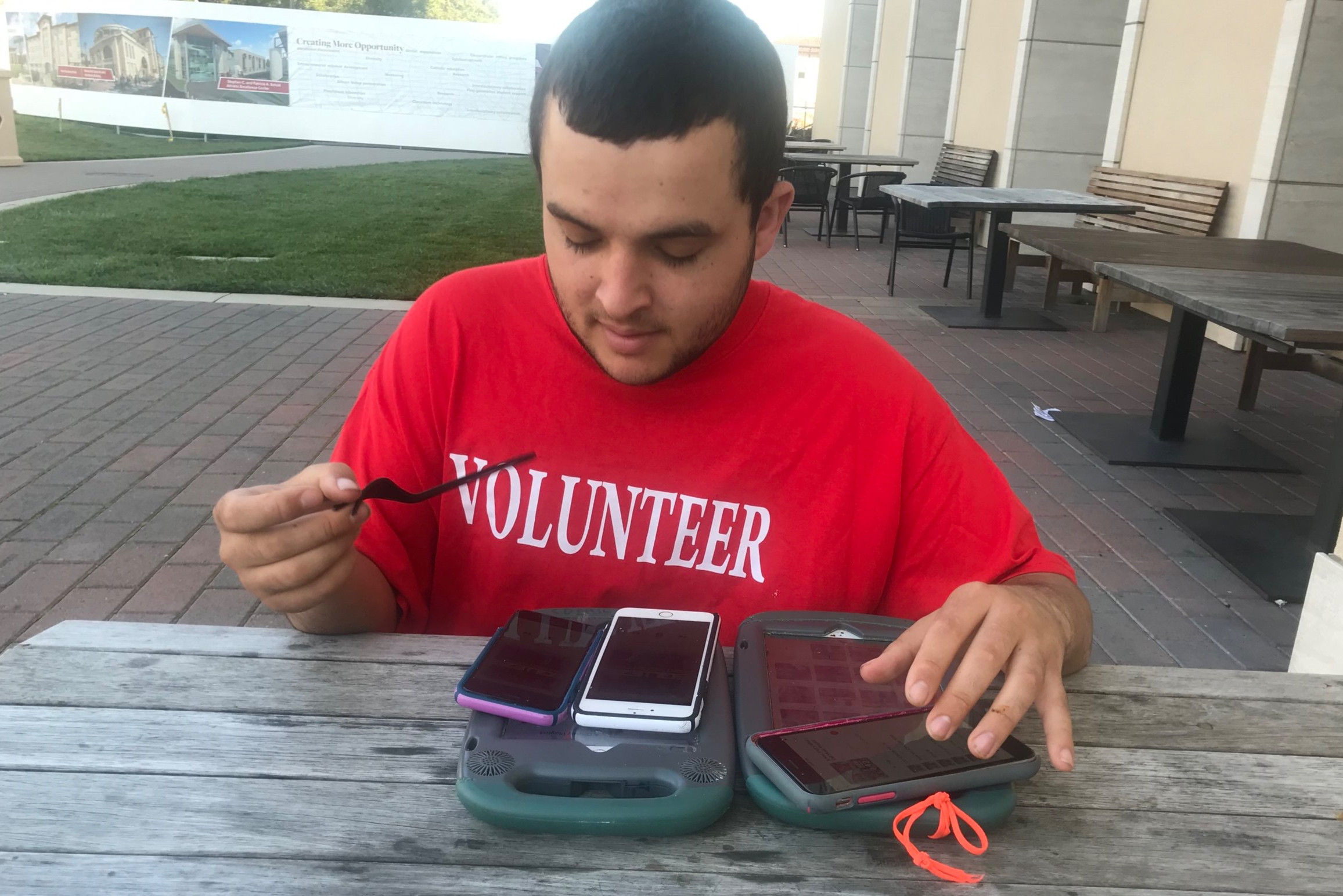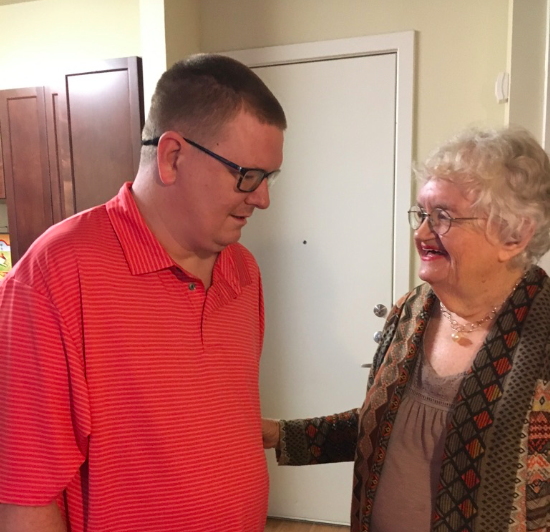At every level the system failed a nonverbal young woman who was raped. Her sister seeks justice and systemwide reform.
Julie Neward on her wedding day with her sister Natalie. (Photo: Stacey Pentland Photography)
People with intellectual disabilities are sexually assaulted at seven times the rate of people without disabilities, according to NPR. One of those victims is Natalie, the younger sister of Julie Neward, who has since transformed into a dogged advocate for the care and protection of our most vulnerable adults. Julie founded Natalie’s Voice, a sexual assault prevention advocacy movement, and the California Sibling Leadership Network, which aims to network and empower siblings of those with developmental disabilities. Interview by Jill Escher, president of NCSA.
Jill: How did you get involved with the issue of sexual abuse of people with intellectual disabilities?
Julie: My sister is a victim. On April 2, 2012 she was diagnosed with gonorrhea, which was life changing. It was a big, huge, raw moment for me. Natalie was born normal but at 27 months of age she suddenly fell into a coma that left her brain damaged. She has the cognitive level of a 10 month old. She’s nonverbal, epileptic, wears diapers, and communicates by moaning and through her beautiful brown eyes. She is exceptionally vulnerable.
Natalie was living at home with our mother and our younger sister, but attended a program in the community. Hindsight is 20-20 and for months prior to her diagnosis the signs and symptoms were quite obvious, but we just did not know. Natalie had been having a difficult time, moaning a lot and not sleeping, which was not like her. Doctors thought she had urinary tract infections and yeast infections. She was also having seizures, which hadn’t happened for years. She was passing bright red blood while being pottied, after returning home via transit from her outside caretaking facility, which prior to her diagnosis doctors thought were hemorrhoids. Then one evening when we were giving her a bath we noticed that her vaginal area was red and swollen. My mother rushed her to urgent care, where for the first time in all her medical visits, a doctor swabbed her for STDs (sexually transmitted diseases).
The following day, while we waited for test results to arrive a few days later, we took her to the emergency room for a sudden onset of seizures, but Natalie was just given medication for a yeast infection and sent home.
And then she was finally diagnosed with gonorrhea?
Yes. We were in shock. It took so long to finally have an answer about what had been causing all this distress. And her doctors hadn’t bothered to look. It was a double shock, learning about the STD and the devastating implication that she had been raped. The system failed her in another way too. The doctors noted Natalie’s low cognitive level, that she cannot consent to sex. This should have triggered state-mandated reporting. But the doctors did not do that.
I called the police. They investigated but did not press charges, which is by far the most typical outcome when a person with intellectual disabilities is raped. We also pulled Natalie out of her program, where the director told us “You should have told us first and not called the police.” I personally told her regional center caseworker what happened. Yet the regional center offered no supports, no one reached out. There was a complete lack of alarm and support from our regional center system. There was no emergency IPP (individual program plan) meeting, no emergency services deployed, and it was not treated like a crime by anybody we told about the situation.
Fast forward a few years, as Natalie’s co-conservator, I pulled her regional center (editor’s note: a California regional center is a nonprofit agency funded by the state to provide and supervise a network of services for people with developmental disabilities) file and began to investigate her records. I sat down with the executive director of our local regional center and walked them through it; it was evident there were errors. In her file, there was no mention of suspected abuse/rape, no police report case number referenced. There was one Special Incident Report (SIR) form in her file filed by her instructor, related to the police investigator inquiring about her history at the program. It was a self-report on the investigator asking about an incident that occurred months prior, where Natalie wandered at an excursion to a bowling alley. After my meeting with the regional center I called Community Care Licensing about the SIR and abuse report; they never received it. The person on the other end stated it was never faxed to them, or that no one in their office was working that area, assumed to be geographic based.
We filed a civil lawsuit against the facility where Natalie had been abused and it led to a confidential settlement. There’s a nondisclosure agreement signed by my mother that I am not at liberty to discuss. But it’s shocking to think that if Natalie didn’t get an STD we would never have known she had been sexually abused in the first place. Because of the privacy laws, the investigator was unable to test the workers at the outside caregiving facility for an STD to narrow down who the abuser could be. Natalie’s perpetrator is still out there.
The system failed Natalie and your family in multiple ways.
Yes. By the place where she was abused. By the regional center. By the medical professionals. By the mandated reporting system. By law enforcement. By Community Care Licensing. There was failure at every level. When the violation was discovered there was no alarm, no response. We need confidence in the regional center system that they can handle and respond to suspected abuse, but there was nothing even included in my sister’s files or to help manage this trauma. The regional center did not even refer us to the Family Justice Center of our county, which addresses sexual assault. We have a full system accountability issue.
How is Natalie doing now?
This happened seven years ago and is still very raw. She’s not in pain anymore, but emotionally you don’t really know. But it became apparent she was likely abused over some period and in multiple ways and that she had suffered terribly. She continues to live with our mother and we directly hire a female caregiver, through the regional center system, who helps take her out in to the community — staying at home all day is no life. Now we know she is in safe hands, but I would love to have more support for my mom at home, she is exhausted.
That’s one reason sibling empowerment is so important. They often have more time and energy than the parents, though it’s often hard for them too. During this traumatic time I got married, had two children and advanced my career. We want to do everything for our siblings but we are also limited by our own lives.
In what ways does having an intellectual disability increase risk for sexual abuse?
I will speak to what I know. Natalie is of a lower cognitive level. She has a special and subtle way of communicating with us but other than that she is nonverbal. A perpetrator is looking for someone like her who cannot talk and does not understand what is going on. People like Natalie can’t defend themselves, can’t report abuse, and can’t provide testimony in court. They are the perfect victims.
Based upon the information I’ve seen, the abuse tends to come from a small population of people who are repeat sexual abusers. The abuse tends to happen during the day, by people the individuals with disabilities know. It’s not at night at the hands of strangers. That’s why it’s so important to catch that one person and stop that multiplier effect. But with a population that is so vulnerable and cannot communicate, everything is just “suspected.” You can change all the laws you want but serial abusers will not show up in criminal background checks because accusations don’t stick.
So what can we do?
We need change at two levels: at the systems level, and also with empowerment of families and individuals. For a start, we need the system to acknowledge the epidemic of sexual abuse. I now sit on the State Council on Developmental Disabilities and am starting to stress that we need to fund education and the response to this crisis. We need a line item in the state’s budget; there is none for this year, but maybe next.
Community Care Licensing is ultimately responsible for the quality of care, but we don’t have real data, it’s all behind the curtain. We have no way of knowing of the volume of confidential settlements, just like with the general #MeToo movement — sexual abusers, and their employers, get shielded by nondisclosures. I think secret settlements are a public health hazard and only protect the perpetrator, allowing them to freely abuse again and again. A close friend suggested that any entity that serves people with I/DD should be legally obligated to disclose nondisclosures, and now the #MeToo movement has really opened the door for that.
Neward with Tarana Burke, founder of the #MeToo movement, and her sisters Patricia (left) and Natalie (right).
I firmly believe there are nondisclosure agreements all over the place and no one knows about them. Facilities and regional centers don’t want histories to be known because the system is stressed and adult services are already in jeopardy. Practitioners and medical professionals need to be more in tune with the I/DD population. I would like to see everyone with I/DD be routinely tested for STDs and other signs of abuse.
Getting down to the level of the individual, prevention of abuse should be embedded in every person-centered plan. This may mean certain type of staffing, or training, or supervision. But usually there is no budget for specialized staffing.
A male support worker was left alone with Natalie long enough to perpetrate sexual acts. Could there have been a plan that a male could not be alone with her?
I have been told that funding issues would prevent 2 on 1 staffing, even for brief periods like diaper changes. The concern is that there is already limited staffing, though at times I have been told an accommodation could be made. I have also been told that if a client is out in the community, it would be challenging to have two people for a diaper change as they would have to neglect someone else. It is not law to have two people and it should be, but we have funding/staffing challenges.
Sorry, back to the question of empowering individuals and families.
Yes, we need to put more power in the hands of the families and individuals, and technology will help us bring this to the next level. Video monitoring and wearable devices can help. I firmly believe we should have cameras in common areas, but this is highly controversial. They offer a false sense of security and we have to be mindful of privacy rights, especially in bathrooms and changing areas. Also, CCTV systems are very costly — it can be hundreds of thousands of dollars. You need someone to be monitoring them and due to storage capacity challenges, the footage may be recorded over within two weeks to a month. There is AngelSense for wandering which is great, but it is limited to GPS and does not take in forensic data that can prove abuse. Remember, abusers are usually known to the suspect in familiar places.
I’ve been working with Dr. Susan Abend of the Right Care Now Project. She has created an “inside-out” medical record system, where loving care providers can input information, not just the doctor. Using an algorithm, the monitoring system assesses health and quality-of-life information for adults with I/DD. The system could potential flag potential problems.
My big dream is that people with I/DD, who consent or have conservators who do, will have wearable devices that can track all sorts of data for quality of life and care. For example, a Fitbit can tell us heart rate, steps, location. If we had wearable technology, we could constantly monitor forensic data, we could see warning signs in real time. Now if a potential perpetrator wants to abuse your daughter he will know she is being monitored, and be less likely to choose her as a victim. This is our most vulnerable population, this should be a commodity for them. I’m on the supervisory committee looking at technology solutions. We want to test this system and we want the state behind it. We are inching toward this program.
Even without technology, people with I/DD tend to have a routine, and patterns in behaviors. When you see people out of their pattern that’s a clue abuse may be happening; when routine is affected, behavior changes. Natalie’s behavior changed, it should have been a sign. Technology will help, but we should always be alert.
What progress do you hope to see in the next ten years?
We need everyone to fully understand that people with I/DD are highly vulnerable to sexual assault. We need truly effective planning and prevention tools, and a system where perpetrators brought to justice. We need families to demand change and accountability. Having a conversation with a caseworker about creating plans around abuse, for before, during and after, does not cost more money. It is a check box. Dr. Nora Baladerian of the Disability & Abuse Project writes about this. I want to see a world where people with I/DD are able to live their lives free from sexual assault, and their loved ones are relieved from worry.
As the mother of two children with nonverbal autism I want to thank you for sharing your family’s story and all you are doing to advance this urgent cause, Julie.
Thanks for speaking with me, Jill.
Julie Neward is a real estate professional and anti-sexual abuse advocate who lives in California. Learn more about her advocacy work at NataliesVoice.net and CaliforniaSibs.org. This interview was edited for length and clarity.
For more information:
Natalie’s Voice NataliesVoice.net
California Sibling Leadership Network CaliforniaSibs.org
People with Intellectual Disability and Sexual Violence, via The Arc https://www.thearc.org/what-we-do/resources/fact-sheets/sexual-violence
Risk Reduction Workbook for parents and service providers ($40) http://disabilityandabuse.org/books/index.htm
“Abused and Betrayed” series on NPR by Joe Shapiro (Natalie’s story featured in “She Can’t Tell Us What’s Wrong”) https://www.npr.org/series/575502633/abused-and-betrayed
Right Care Now (Susan Abend) rightcarenowproject.org
Julie Neward on Lomah podcast (“Advocating Against the Sexual Assault Epidemic”) https://www.lomah.org/podcast2/66
Cameras in schools: http://tash.org/wp-content/uploads/2015/01/Cameras-in-School-Final.pdf)






















